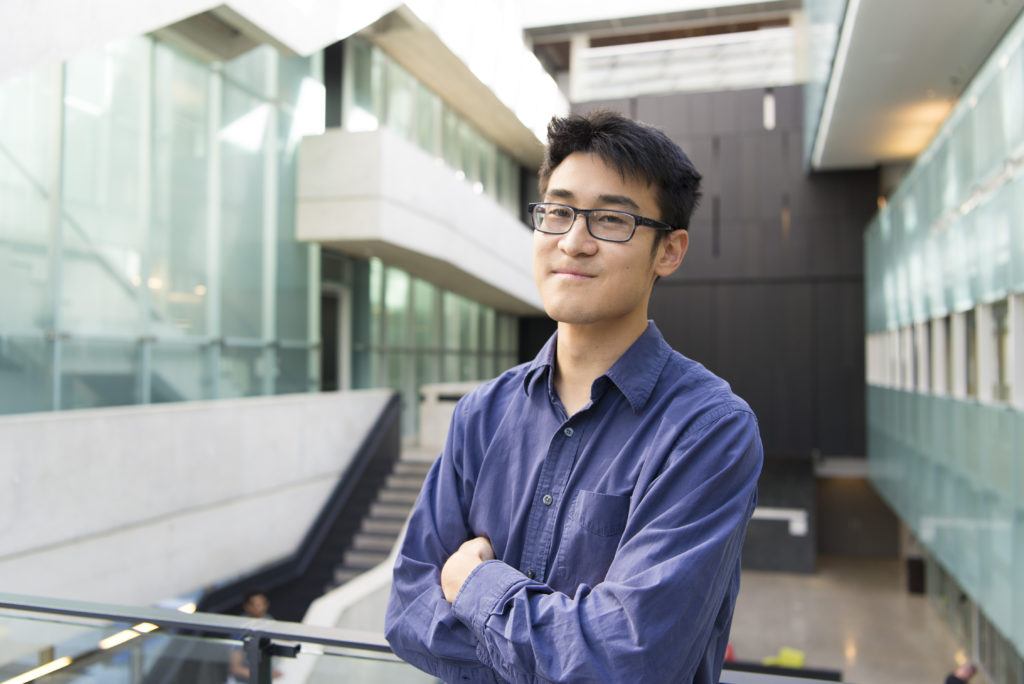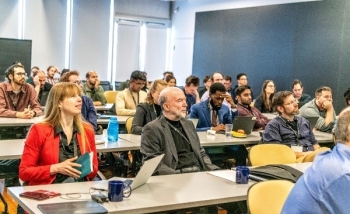It can be easy to forget or ignore, but the universe is quantum, top to bottom. All processes are, on some level, quantum processes. All materials – from the most exotic Bose-Einstein condensate to the most ordinary ice cube – are quantum materials.
But some materials are more quantum than others. And some quantum materials, says Perimeter Faculty member Timothy Hsieh, are magic.
He’s not speaking metaphorically. ‘Magic’ has a technical meaning in quantum theory, and Hsieh has just found a huge source of it.
“You could say that all materials are quantum materials. They just differ in the extent to which quantum physics is required to understand the important phenomena,” Hsieh says. “In the vast majority of materials, quantum physics is relevant in some sense, but it is relevant in different ways.”
Material properties – quantum or not – depend on structure, chemical makeup, and the phase (or state) of the matter.
In everyday life, people typically experience three phases of matter: solids, liquids, and gases. Many properties are affected by the phase: shape, colour, electrical and heat conductivity, elasticity, fluidity, and more.
Even though these properties emerge from deep quantum structures, many of them can be – and usually are – described using classical physics. You can trigger a transition from one phase to another by adjusting (or ‘tuning’ in physicist lingo) factors like temperature or pressure.
Many less-familiar phases of matter are dominated by more overtly quantum properties like superconductivity, superfluidity, particle spin, entanglement, and unusual forms of magnetism. The factors that can trigger phase transitions in quantum materials are equally unusual.
“These quantum phases can be tuned by very different parameters than solids, liquids, and gases,” Hsieh says. “You wouldn’t be tuning temperature, for example, to access two different phases. You’d be adjusting the interactions of particles in your systems instead.”
Hsieh has become increasingly intrigued by the practical potential of some of these materials, particularly those related to quantum computing.
Quantum computers store and process information using the physical properties of materials that belong entirely to the quantum realm. Quantum bits (or ‘qubits’) of information can be encoded in the spin of an electron, the magnetic resonance of an atomic nucleus, or the polarization of a stream of photons.
Scientists build up the complexity of the system by ‘entangling’ qubits. Qubits become entangled when they interact with each other in such a way that the properties of one become linked to the properties of others – a relationship that remains even when the entangled particles are separated by a large distance.
In principle, the potential of qubits is huge: certain types of complex calculations that would be formidable for even the world’s most powerful classical supercomputers could be done quickly with just a few tens or hundreds of entangled qubits.
In practice, working with qubits is scientifically and technologically demanding. Small disturbances can create errors or collapse the whole system. And even though the classical world and the quantum world are merely two ways of interpreting the same reality, it is still challenging to move information from one realm to the other.
Over time, though, physicists have created more and more powerful, reliable, and flexible quantum computers. However, they’ve often had to trade better reliability for less flexibility. The holy grail is a quantum machine that is both fault tolerant and universally programmable.
“That’s where the magic comes in,” Hsieh says.
In quantum information, the term ‘magic’ refers to a resource that is essential to building universally programmable quantum computers. Magic is a type of complex quantum state that can’t be captured in classical computers. It is the means by which physicists can achieve full-fledged quantum computing.
Magic moves quantum computing from task-specific technology to universal quantum computing applications.
In a recent paper in the journal Quantum, Hsieh and his co-authors – including former Perimeter Visiting Graduate Fellow Tyler D. Ellison (whom Hsieh calls a driving force behind the work), Perimeter postdoctoral researcher Zi-Wen Liu, and University of Osaka Faculty member Kohtaro Kato – describe their analysis of a category of magic-rich materials that are types of symmetry-protected topological (SPT) phases of matter.
“SPTs are well-known phases of matter,” Hsieh says. “What we did in the paper was find that a large class of these phases actually contain this magic resource. In some phases, every representative in the phase contained magic. It's not just like one particularly fine-tuned model that has it; everything in the whole phase has magic.”
“Now that we know such materials contain all this magic, how would we harness this resource?” he asks. “What protocol can you use to distill this magic, and to connect it to the next steps in quantum computation?”
Hsieh says Perimeter provides an excellent environment in which to pursue these questions. At the Institute, he can access experts in many related areas of physics. The culture of interdisciplinary collaboration suits his ambitious, multi-year research agenda.
“The integration of all these areas of theoretical physics in one building is very unique,” he says. And with strong support for researchers interested both in theories and in applications, Perimeter Institute provides an ideal intellectual home where Hsieh can make the magic happen.
Further exploration
About PI
Perimeter Institute is the world’s largest research hub devoted to theoretical physics. The independent Institute was founded in 1999 to foster breakthroughs in the fundamental understanding of our universe, from the smallest particles to the entire cosmos. Research at Perimeter is motivated by the understanding that fundamental science advances human knowledge and catalyzes innovation, and that today’s theoretical physics is tomorrow’s technology. Located in the Region of Waterloo, the not-for-profit Institute is a unique public-private endeavour, including the Governments of Ontario and Canada, that enables cutting-edge research, trains the next generation of scientific pioneers, and shares the power of physics through award-winning educational outreach and public engagement.
You might be interested in




